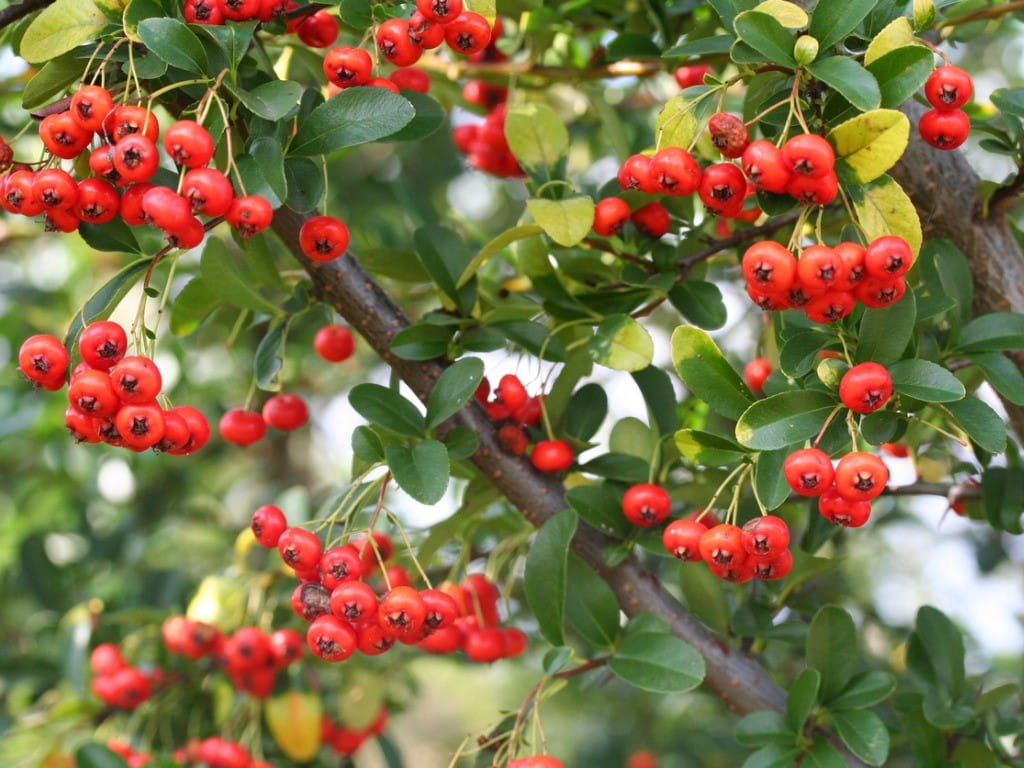Are Pyracantha Berries Poisonous?

The Bottom Line
Pyracantha is an evergreen shrub often used in landscaping. The shrub typically has plentiful orange-red berries and needle-like thorns. The berries have not been shown to be toxic to animals or humans, although swallowing large amounts might cause some mild stomach upset.

The Full Story
Pyracantha, also known as firethorn, is an evergreen shrub that belongs to the plant family Rosacea. There are several species including Pyracantha angustifolia, Pyracantha coccinea, Pyracantha fortuneana, and Pyracantha koidzumii. Although the appearance can differ depending on the species, the shrub typically has shiny evergreen foliage, white flowers, clusters of orange-red berries, and needle-like thorns. The size can range from 5 to 12 feet high and 6 to 8 feet wide. Plant hybrids offer smaller sizes as well as variations in berry color. In addition to year-round interest from the leaves, flowers, and berries, the shrub can be used as a natural barrier because of the dense thorns. The shrubs can be planted close together in lieu of fences and below windows to deter intruders.
The berries and thorns are the parts of the shrub most likely to be involved in a potentially poisonous exposure. Children are attracted to the bright berries, and ingestions are fairly common since the berries are easily within reach. Fortunately, the berries are not considered poisonous even though they contain miniscule amounts of a cyanide-like compound. A study of dogs and other mammals found that the animals readily swallowed large amounts of berries when offered and did not show any signs of toxicity. Some bird species regularly eat Pyracantha berries.
Serious toxicity has not been reported in humans, whether it is an unintentional ingestion of a few berries by a toddler or a deliberate ingestion of handful amounts in an attempt to self-harm. The main risk with ingestion of large quantities of berries is mild gastrointestinal irritation such as nausea and vomiting, which would happen within 15 to 30 minutes. A choking hazard is also possible if small children try to swallow several berries at once. Ingestion of a few berries is considered non-toxic. In fact, some components extracted from Pyracantha berries are being studied for potential health benefits; however, there are no current recommendations to eat the berries. There is no specific treatment for anyone swallowing the berries.
Puncture wounds from the thorns happen easily as anyone who has tried to prune these shrubs will attest. Although the thorns are not considered toxic, the skin around the puncture wound can become red, swollen, painful, and itchy. These symptoms are uncomfortable but not dangerous. Pyracantha thorn injuries can be managed at home by removing the thorn with tweezers, washing the puncture site with soap and water, and using an over-the-counter topical product for itching and inflammation. In the event the puncture wound becomes infected, a health professional should be seen. Most dangerous is when a thorn becomes embedded in a joint such as in the hand. These situations can result in inflammation to the tendon and surrounding membranes causing pain, swelling, stiffness, and reduced range of motion. Anyone with an embedded thorn should see a health professional for removal and treatment. Pyracantha thorn injuries can be minimized by always wearing heavy gloves and eye protection when handling the branches.
If you suspect someone has swallowed Pyracantha berries, check the webPOISONCONTROL® online tool for guidance or call Poison Control at 1-800-222-1222. If someone has been injured by a Pyracantha thorn, wash the area well and seek medical evaluation if an infection occurs or if the thorn is embedded under the skin.
Karen D. Dominguez, PharmD
Certified Specialist in Poison Information
Poisoned?
Call 1-800-222-1222 or
Prevention Tips
- Know the names of the plants on your property in case one is unintentionally swallowed.
- Children might not be able to distinguish edible plants from non-edible plants, so teach them not to put any part of a plant in their mouth without checking with an adult first.
- Adults should not eat outdoor plants or make teas, etc. with these plants unless they have been determined to be safe.
- Take care when gardening around Pyracantha shrubs to avoid thorn injury and wear thick gloves and eye protection when handling the branches.
This Really Happened
A school nurse called Poison Control because seven 4th and 5th grade boys were eating Pyracantha berries at school. All the boys were fine, but the nurse was concerned about the potential for poisoning. The nurse was advised that the boys might develop some mild stomach upset but that there was no need for medical evaluation.
For More Information
Pyracantha. Clemson SC: Clemson Cooperative Extension; 14 May 1999 [accessed 27 Aug 2018].
References
Pyracantha coccinea. In: Frohne D, Pfander HJ. Poisonous plants a handbook for doctors, pharmacists, toxicologists, biologists and veterinarians. 2nd ed. Portland OR: Timber Press; 1984. p. 335-6.
Pyracantha roem. In: Burrows GE, Tyrl RJ. Toxic plants of North America. 2nd ed. Hoboken NJ: Wiley-Blackwell; 2013. p. 1085-6.
Poisoned?
Call 1-800-222-1222 or
Prevention Tips
- Know the names of the plants on your property in case one is unintentionally swallowed.
- Children might not be able to distinguish edible plants from non-edible plants, so teach them not to put any part of a plant in their mouth without checking with an adult first.
- Adults should not eat outdoor plants or make teas, etc. with these plants unless they have been determined to be safe.
- Take care when gardening around Pyracantha shrubs to avoid thorn injury and wear thick gloves and eye protection when handling the branches.
This Really Happened
A school nurse called Poison Control because seven 4th and 5th grade boys were eating Pyracantha berries at school. All the boys were fine, but the nurse was concerned about the potential for poisoning. The nurse was advised that the boys might develop some mild stomach upset but that there was no need for medical evaluation.
